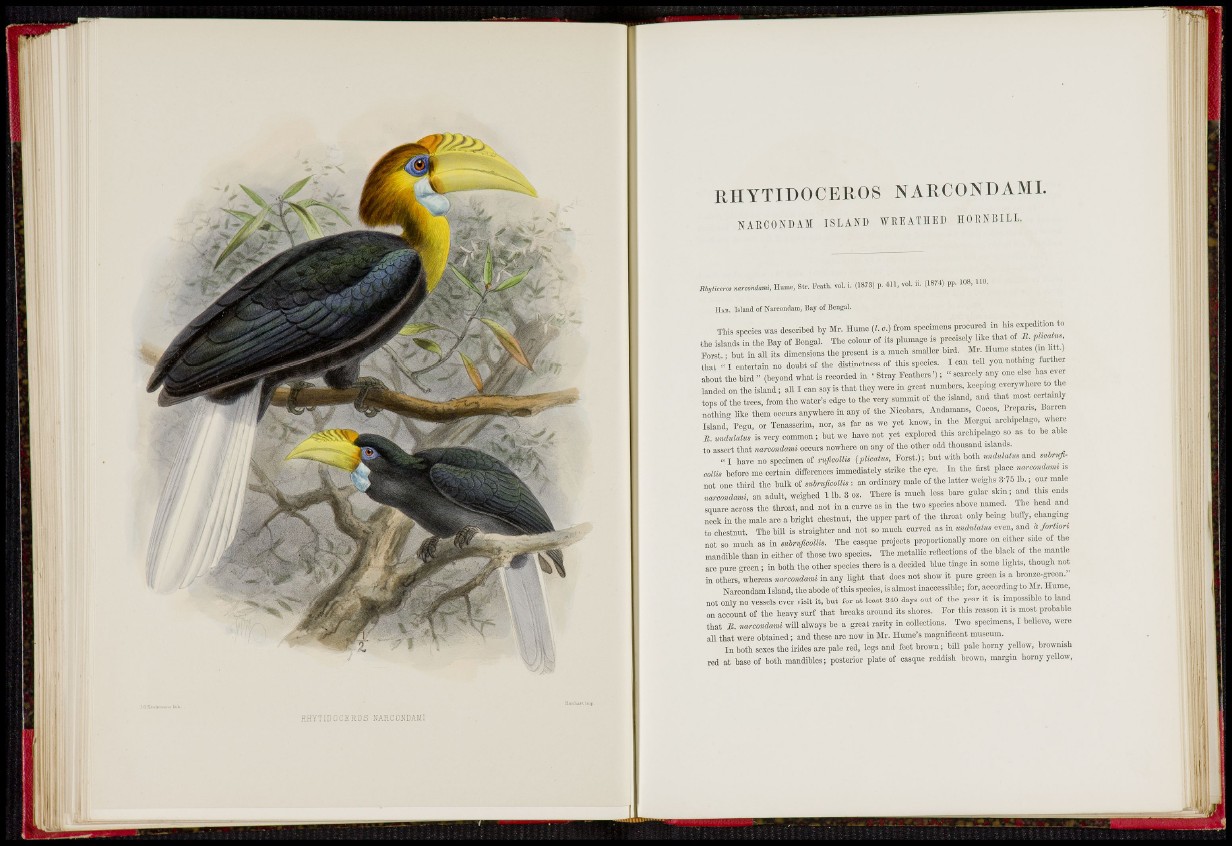
RKYTmnfiliROS »ARCONDAMI
RHYTIDOCEROS NARCONDAMI.
N A E C O N D A M ISLAND WEEATHEl) HOESBIEL.
Ham., SI,. F...1.. vol. i. (187S) p. 411. ,ol. i,. (ISM) pp. lOS, 110.
HAH. Island of Narcondam, Bay of «engal.
This species was deseribed by Mr. Hume (!. o.) from speeimens proeuvcd in
the islands in the Bay of Bengal. The coionr of its plumage is precisely like that 0 E.
I W • bnt in all its dimcnsicn, the present is a much smaller bird. Mr. Hume states (in I t.)
that •• I entertain no donbt of the distinctness of this spccies. I can tell you notlimg further
about the bird " (beyond what is recorded in • Stray Feathers •); " scarcely any one else has ever
landed on the island; all I can sav is that they were in great numbers, keeping evcrywliere to the
Tps cf the trees, from the water's edge to the very summit of the island, and that most cer^^am y
nothing like them occurs anywhere in an, of the Kicobars, Andamans. Cocos. I'reparis, Ba ren
Island. Pegu, or Tenasserim, nor, as far a, we yet know, in the Mergui arehipclago whore
B „ululatm is very common; but we hare not yet explored this archipelago so as to be able
,0 assert that «.«.»damiocenrs nowhere on any of the other odd tiiousand islands.
" I have no specimen of ruficollis Forst.); but with both . » « » ¡ a . and suhru],-
collis before me certain differences immediately strike the eye. In the first place naroondam, is
not one tbild the bulk of mhrnficolUs , an ordinary male of the latter weighs 3'75 lb.; our male
an adult, weighed 1 lb. 3 o.. There is much less bare gular skin, and this ends
square across the thi-oat, and not in a curTc as in the two spccies aboTC named. Ihe head and
neok in the male are a bright chestnut, the upper part of the throat only being buffy, changmg
to chestnut. The bill is straighter and not so much curTod as in uMatm oven, and « fortu,r,
not so much as in mlr.ficoUh. The casque projects proportionally more on either side of the
mandible than in either of those two species. The metallic reflections of the black of the mantle
ai-e pure green; in both the other species there is a decided blue tinge in some lights, though not
in others, whereas mnondav,i in any light that does not show it pure green is a bronze-green.'
Narcondam Island, the abode of this species, is almost inaccessible; tor, aceordmg to Mr. Hume,
not only no vessels ever visit it. but for at least 310 days out of the year it is impossible to land
on account of the heavy surf that breaks around its shores. For this reason it is most probable
that E. naroonimni will always be a great rarity in eoneetions. IVo specimens. I believe, were
all that were obtained; and these are now in Mr. Hume's magnificent museum.
In both seies the irides are pale red, legs and feet brown; bill pale horny yellow, brownish
red at base of both mandibles; posterior plate of casque reddish brown, margin horny yellow.
i l i a